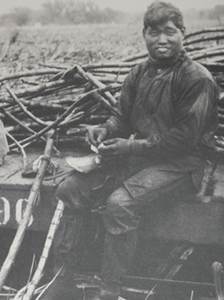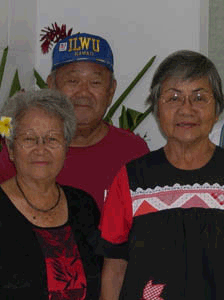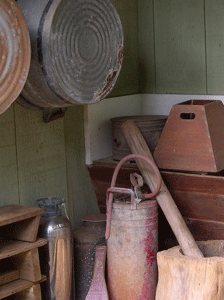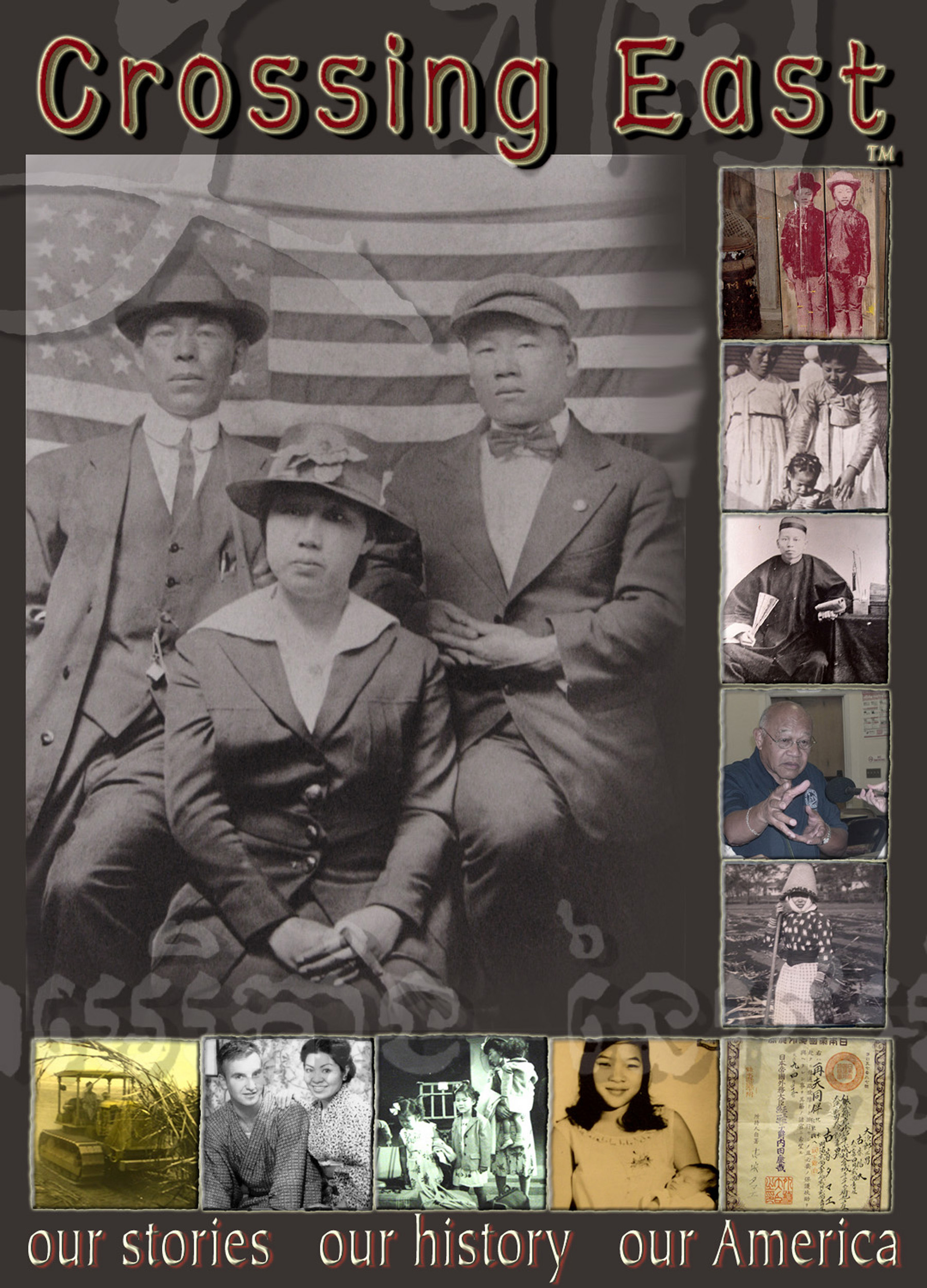Hawaii was a self-contained society when Captain Cook made first contact. Then settlers and missionaries turned Hawaiians into workers and the islands into plantations.
Produced by Robynn Takayama and Dmae Roberts with assistance by Jennifer Dunn.
Special thanks to Chris Conybeare of Rice & Roses Video
Listen: Crossing East Program 3 – Raising Cane
S egment One: Hard Labor
egment One: Hard Labor
First they used Hawaiian labor on the plantations. But it was Hawaiian tradition to work only to meet immediate needs. So there was no year-round workforce. By 1850, the sugar industry exploded. Plantations needed cheap labor. Fast. The first workers came from China. Then Japan, Korea, the Philippines… The laborers had hopes of making money quickly and returning home. Raising Cane was backbreaking work and the pay was meager. Men who came to Hawaii had big dreams. They thought they would strike it rich. But the reality of plantation life was so different from what they were told by recruiters.
Acknowledgements:
Gaylord Kubota, Domingo Los Banos, Espy Garcia, Ah Quon McElrath, Barbara Kawakami, Alma Ogata, Fuzzy Alboro, George Fujiwara, May Fujiwara, Jon Arisumi. Moses Pataki, and Richard Nagame. Scholars Ronald Takaki, Franklin Odo, Bill Puette, William Boylan, Lee Tonouchi, Kent Sakoda and Jeffrey Siegel. Actors Dann Seki, Chisao Hata, Denise Aoki Chinen, and Keith Kashiwada. Hole Hole Bushi songs were sung by Shigeko Miyashiro.
Produced by Robynn Takayama and Dmae Roberts
 Segment Two: Picture Brides
Segment Two: Picture Brides
In 1900, the plantations were bachelor societies. Some men married native Hawaiian women. Wealthier men returned home to find brides. A 1907 law, The Gentleman’s Agreement, allowed only family members to immigrate. So many Japanese, Okinawan, and Korean men asked their families to help arrange a marriage across the ocean.
Acknowledgements:
Gaylord Kubota, Domingo Los Banos, Espy Garcia, Ah Quon McElrath, Barbara Kawakami, Alma Ogata, Fuzzy Alboro, George Fujiwara, May Fujiwara, Jon Arisumi. Moses Pataki, and Richard Nagame. Scholars Ronald Takaki, Franklin Odo, Bill Puette, William Boylan, Lee Tonouchi, Kent Sakoda and Jeffrey Siegel. Actors Dann Seki, Chisao Hata, Denise Aoki Chinen, and Keith Kashiwada. Hole Hole Bushi songs were sung by Shigeko Miyashiro.
Produced by Robynn Takayama and Dmae Roberts
Picture Brides Archival Material
 Segment Three: Resistance
Segment Three: Resistance
In the 20th century, workers began to demand higher wages. Though vulnerable to exploitation, workers slowly gained strength through both individual and collective action. Organized protests began along ethnic lines in the early 1900s. Plantation owners exploited racial differences. They pitted workers against each other. Workers needed higher wages to support their families and a new strategy to beat the plantation system. In 1946, they organized the first multi-ethnic strike led by the International Longshoremen’s and Warehousemen’s Union. The “Great Sugar Strike,” transformed Hawaii’s plantation society. With a union victory, Hawaii’s sugar workers became the highest paid agricultural workers in the world. But the building blocks of this movement began many years earlier.
Acknowledgements:
Gaylord Kubota, Domingo Los Banos, Espy Garcia, Ah Quon McElrath, Barbara Kawakami, Alma Ogata, Fuzzy Alboro, George Fujiwara, May Fujiwara, Jon Arisumi. Moses Pataki, and Richard Nagame. Scholars Ronald Takaki, Franklin Odo, Bill Puette, William Boylan, Lee Tonouchi, Kent Sakoda and Jeffrey Siegel. Actors Dann Seki, Chisao Hata, Denise Aoki Chinen, and Keith Kashiwada. Hole Hole Bushi songs were sung by Shigeko Miyashiro.
Produced by Robynn Takayama and Dmae Roberts
 Segment Four: Plantation Life
Segment Four: Plantation Life
Plantation workers lived in camps next to the sugar and pineapple fields. The plantations segregated them – there was Chinese camp, Filipino camp, Puerto Rican camp and so on. The Camps had a hierarchy—wealthy owners at the top, followed by the Lunas or Managers who were usually European. Then at the bottom, the workers—mostly from Asia. Conditions were often squalid until families took steps to improve their own lives.
Acknowledgements:
Gaylord Kubota, Domingo Los Banos, Espy Garcia, Ah Quon McElrath, Barbara Kawakami, Alma Ogata, Fuzzy Alboro, George Fujiwara, May Fujiwara, Jon Arisumi. Moses Pataki, and Richard Nagame. Scholars Ronald Takaki, Franklin Odo, Bill Puette, William Boylan, Lee Tonouchi, Kent Sakoda and Jeffrey Siegel. Actors Dann Seki, Chisao Hata, Denise Aoki Chinen, and Keith Kashiwada. Hole Hole Bushi songs were sung by Shigeko Miyashiro.
Produced by Robynn Takayama and Dmae Roberts
Plantation Life Archival Material
 Segment Five: Pidgin English
Segment Five: Pidgin English
Talk Story is a term used in Hawaii for people gathering together for conversation, to tell stories… on the plantations, people of different ethnicities had to find a way to communicate, so they created a common language to talk to each other. On the Islands, you hear “brah” for “brother,” Stink Eye for “dirty look” and “dakine” for “whatchamacallit.” Islanders call it Pidgin English but it’s a mixture of Chinese, Japanese, Korean, Filipino, Portuguese and Hawaiian.
Acknowledgements:
Gaylord Kubota, Domingo Los Banos, Espy Garcia, Ah Quon McElrath, Barbara Kawakami, Alma Ogata, Fuzzy Alboro, George Fujiwara, May Fujiwara, Jon Arisumi. Moses Pataki, and Richard Nagame. Scholars Ronald Takaki, Franklin Odo, Bill Puette, William Boylan, Lee Tonouchi, Kent Sakoda and Jeffrey Siegel. Actors Dann Seki, Chisao Hata, Denise Aoki Chinen, and Keith Kashiwada. Hole Hole Bushi songs were sung by Shigeko Miyashiro.
